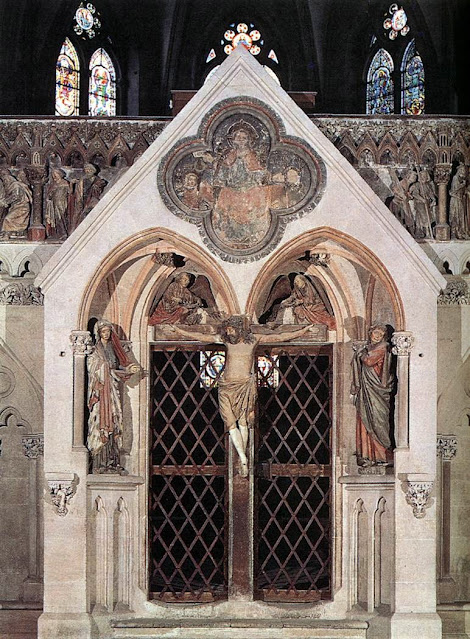 |
| Andrea de Firenze, Crucifixion Italian, 1470-1377 Vatican City, Pinacoteca |
“Standing by the cross of Jesus were his mother and his mother’s sister, Mary the wife of Clopas, and Mary of Magdala. When Jesus saw his mother and the disciple there whom he loved, he said to his mother, “Woman, behold, your son.” Then he said to the disciple, “Behold, your mother.” And from that hour the disciple took her into his home.” (John 19:25-27)
Each of the Gospels provides a listing of the witnesses to the Crucifixion, but only John mentions the presence of the Virgin Mary, mother of Jesus, and “the disciple whom he loved”, who is traditionally believed to be John himself. Mark (Mark 15:40) and Matthew (Matthew 27:56) give us the names of Mary Magdalene and Mary, the mother of James and Joseph (or Joses) and another woman who is identified as the mother of the sons of Zebedee by Matthew and as Salome by Mark. Luke mentions only that “all his acquaintances stood at a distance, including the women who had followed him from Galilee and saw these events” (Luke 23:49).
Yet, it is the description in the Gospel of John that has formed the visual imagery of the Crucifixion, almost from the earliest times. This may be due to the extra drama introduced by the dialogue between Jesus, Mary and John, in which Jesus, as it were, gives his mother a new son and gives his disciple a second mother.
 |
| Anonymous, Rabula Gospels Syrian, 586 Florence, Biblioteca Medicea Laurenziana MS Plutei 01.56, fol. 13r |
It is this trio of Jesus, Mary and John that has formed our core image of the Crucifixion from as early as the sixth century. In the Rabula Gospels, written in Syria in the late sixth century, we see this already to be true. Other persons may be included in images of the Crucifixion, but these two figures are always there. And the figure of John, while unmistakably dressed in male clothing, is always an image of the young, beardless man.
_875-1000_BNF_Latin+943_fol.+4v.jpg) | ||||||||||
| Pontificale Shirborniensis, Crucifixion English (Canterbury), 875-900 Paris, Bibliotheque nationale de France MS Latin 943, fol. 4v |
 |
| Missale S. Dionysii, Crucifixion French (Arras), ca. 1050 Paris, Bibliotheque nationale de France MS Latin 9436, fol. 16 |
 |
| Gospel Book, Crucifixion German (Pruem), ca. 1100-1130 Paris, Bibliotheque nationale de France MS Latin 17325, fol. 28 |
 |
| Psalter of St. Louis and Blance of Castille Crucifixion French, ca. 1225 Paris, Bibliotheque nationale de France MS Arsenal 1186, fol. 24 |
 |
| Ivoy Pax, Crucifixion South German, ca. 1360-1370 New York, Metropolitan Museum of Art. the Cloisters |
 |
| Pietro Perugino, Calitzin Triptych (center) Italian, 1481-1485 Washington, D.C., National Gallery of Art |
So ubiquitous were these images that nearly every church, even many of
the most humble, included a statuary group of three figures, Jesus, Mary
and John.
This group might stand at the entrance to the church or atop a screen
between the altar area and the nave (called in England a rood screen,
from the old English word for cross). Most were demolished in the
Reformation and during subsequent centuries, but some survive in situ
and parts of others survive in museums and private collections.
_13th+c_Met.jpg) |
| Anonymous, Mourning Virgin Austrian (Tyrol), 13th Century New York, Metropolitan Musuem of Art |
 |
| Anonymous, St. John the Evangelist Austrian (Tyrol), 13th Century New York, Metropolitan Museum of Art |
Interestingly, the one person about whose presence there is complete
agreement in the Gospels is Mary Magdalene. Clearly, she was a witness.
However, it is not she who is shown at all times and in all places.
Her presence appears primarily in later images of the Crucifixion,
apparently beginning in the 14th century.
 |
| Giotto, Crucifixion Italian, 1304-1306 Padua, Arena Chapel |
She is clearly distinguished from John whenever she is shown. John is
always shown in relation to the Virgin Mary, either as her exact pendant
figure (one on each side of the cross) or as her masculine supporter.
Mary Magdalene is frequently seen only in relation to Jesus. She is
the emotionally reactive figure, kneeling at the foot of the Cross or
bewailing the event. She is usually shown in somewhat more extravagant
feminine garb that the usually conservative Virgin. Also she often,
though not always, appears with unveiled hair. She is very clearly
female. And her femininity reinforces John’s masculinity.
 |
| Andrea Mantegna, Crucifixion Italian, 1457-1459 Paris, Musee du Louvre |
_1495-1500_Morgan_h5.079r.jpg) |
| Anonymous, Crucifixion from a Book of Hours Franch (Paris), 1495-1500 New York, Morgan Library MS H5, fol. 79r |
 |
| Matthia Gruenwald, Crucifixion (central panel of the Isenheim Altar) German, ca. 1515 Colmar, Musee d'Unterlinden |
 |
| Constantine Brumidi, Crucifixion Italian-American, 1870-1880 New York, Church of the Holy Innocents |
Nothwithstanding a few solitary examples, there is not, nor ever was, any visual confusion that John, a young beardless man, is the primary witness to the Crucifixion, in spite of the fact that the three Synoptic1 Gospels tell a somewhat different story!
© M. Duffy, 2014/2024
_____________________________________________
1. The Synoptic Gospels are the three Gospels attributed to Matthew, Mark and Luke, which share many of the same stories and other material, as opposed to the very different, more theologically oriented, Gospel of John.


_1220-30_Morgan_g25.002v.jpg)


_1582_Francois-Hercule+de+France+a+la+Messe_BNF_Latin+10564_fol.+6v.jpg)









_1954_Met.jpg)
No comments:
Post a Comment